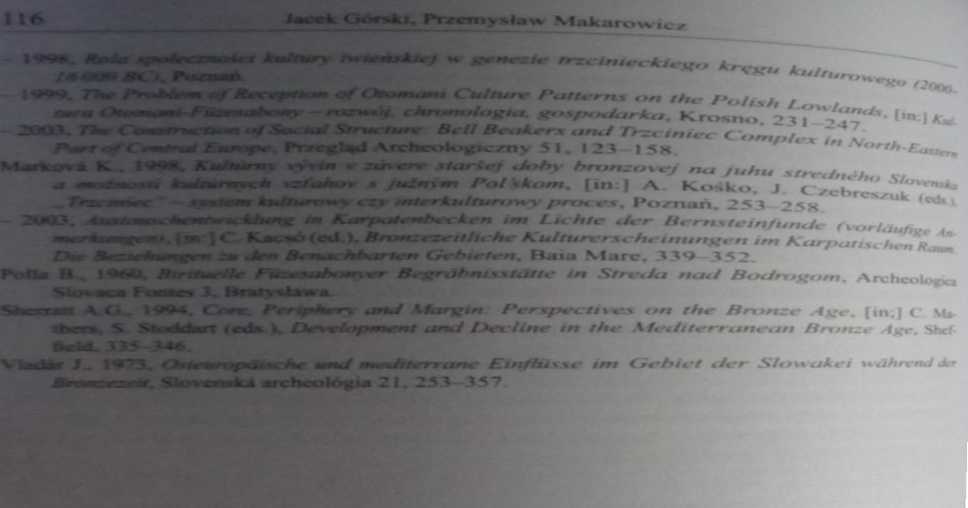P1190280

ACTA UNIYERS1TAT1S WRATISLAYIENSIS No 2960 Studia Archeologiczne XL Wrocław 2007
MARCIN S. PRZYBYŁA'
THE INFLUENCES
OF THE MIDDLE DANUBIAN URNFIELD CULTURE ON THE SILESIAN GROUP OF THE LUSATIAN CULTURE IN THE YOUNGER PERIOD OF THE BRONZE AGE
I
The issues of the relations betwecn the Lusatian culture and the Middle Dan-ubian Uroficld culture was widely discusscd in archacological literaturę at the end of the first half of 20* cent. (Bukowski 1969: 249-257 - the review of literaturę there). At that time a conviction pen aded. that a supposed expansion of the Lusatian culture to the south played a significant role in the process of forma-tion of umfield type groups in the Danube region. However, the development of the research on the genesis of the Middle Danubian Umfield culture allowed Jiri ftihovsky (1961: 249-250; 1982: 88, 96) to State that this group developed from the local variation of the Tumulus culture, and the influences of the Lusatian cul-Hre played no significant role in that process.
Due to the conviction about the pcrvading role of the Lusatian culture. an at-tempt to find traccs of the influences arriving on this culture’s territory from the wuth was madę in the Polish archacological literaturę comparatively late and to a small extcm. Z. Bukowski (1969: 253). when discussing the issues of the contacts hctwccn the Lusatian and the Velatice culture. limited himself only to enumerat-ngi after J. Rihovsky, a few vesscls typical of the Velatice culture and found in 'he Silesian group territory. In his opinion, their presence may prove that minor ruups of the population pcnctrated sparsely populated borderlands (ibidem).
M. Gedl, in his study on the Lusatian culture in Upper Silesia (1962: 28-29, ■ł), mentioncd three cylinder-neckcd vases with cverted rim from Wojno wice md lizierżysław as well as a double-bodied vessel from Branice (all the sites are loc**ed in the district of Głubczyce), interpreting them as a sign of the influence ,om Bohemia. The same group of finds cnriched by further artefacts - especially
InkUlute of Archacology, Jagieł lonmn Univcrsity, Cracow.
Wyszukiwarka
Podobne podstrony:
P1190280 ACTA UNIYERS1TAT1S WRATISLAYIENSIS No 2960 Studia Archeologiczne XL
P1190256 ACTA UNIVERSITATIS WKATISLAV1ENSI5 No 2960 Studia Archeologiczne XL
P1190347 (2) ACTA UNIVERSITAT1S WRATISLAYIENSIS No 2960 Studia Archeologiczne XL &n
P1190256 ACTA UNIVERSITATIS WKATISLAV1ENSI5 No 2960 Studia Archeologiczne XL
33539 P1190256 ACTA UNIVERSITATIS WKATISLAV1ENSI5 No 2960 Studia Archeologiczne XL
P1190347 (2) ACTA UNIVERSITAT1S WRATISLAYIENSIS No 2960 Studia Archeologiczne XL &n
40367 P1190301 ACTA UNIVERSITAnS WRATISUWIENSIS No 2960 Studia AlChcotogictnc XL &n
P1190301 ACTA UNIVERSITAnS WRATISUWIENSIS No 2960 Studia AlChcotogictnc XL Wr
P1190340 (2) ACTA UNIVtRSITATiS WRATISLAVIENSIS So 2960 Studia Archeologiczne XL &n
P1190340 (2) ACTA UNIVtRSITATiS WRATISLAVIENSIS So 2960 Studia Archeologiczne XL &n
P1190319 ACTA UNIVERSITATIS WRATISI.AVIENS1S No 2960 Studi
P1190319 ACTA UNIVERSITATIS WRATISI.AVIENS1S No 2960 Studi
85637 P1190319 ACTA UNIVERSITATIS WRATISI.AVIENS1S No 2960 Studi
85637 P1190319 ACTA UNIVERSITATIS WRATISI.AVIENS1S No 2960 Studi
P1190319 ACTA UNIVERSITATIS WRATISI.AVIENS1S No 2960 Studi
ACTA UNIVERSITATIS WRATISLAVIENSIS No 3504 Studia nad Autoiytaryzmem i Totalitaryzmem 34, iw 3 Wrocł
832 Bibliografia prac Profesora Jana Boda fesora Jana Jendrośki, Acta Universitatis Wratislaviensis
więcej podobnych podstron